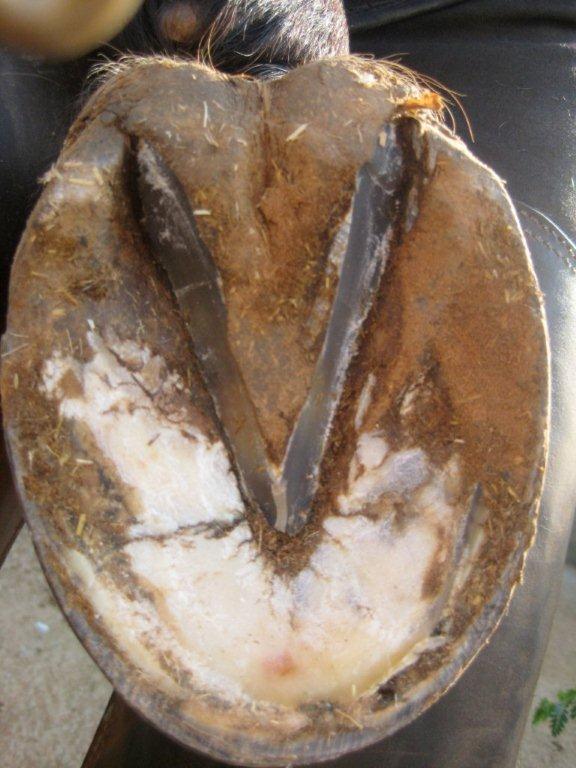Trimming and debridement of affected tissue is the cornerstone of treating frog disease. This process must be continued long enough to remove all diseased tissue (which may be days or weeks) and frequently enough to remove compromised horn as it grows out before the disease process has a chance to extend deeper into the frog. Initial treatment involves the removal of as much diseased tissue as possible without invading the live frog plane. The image in Fig. 36 may be helpful to understanding the anatomy of this area. As a general guideline, removal of compromised horn should not cause pain, lameness or bleeding. If in doubt, err on the side of being conservative. The frog grows quickly and it is better to remove tissue gradually over several days than to risk further damage to the frog by overzealous trimming. Fig. 36. Photo courtesy of Jenny Edwards (http://www.all-natural-horse-care.com/)
If at all possible, the horse should be trained to allow a person seated on a rolling mechanic's stool to work with the upturned hoof placed in a towel–draped lap (Fig. 37). This method greatly facilitates accurate and effective treatment; please make sure your horse is completely reliable when handled this way. We have easily and successfully taught this method to horses as old at seventeen years and as young as five months with no problems. It is not recommended to crosstie horses being worked on in this way. A second handler at the head is helpful for horses learning to accept this method and adds a degree of safety for the trimmer.
Good lighting is essential for thorough examination and trimming. Occasionally one stumbles upon problems by accident, but generally very methodical probing and painstaking cleaning of all the sulci, as well as thorough investigation of any soft and/or discolored areas is necessary to insure that all diseased portions are identified and treated. Proper tools are a necessity. These include sharp left and right handed hoof knives, preferable with a small curl. Diseased tissue can be difficult to cut as it tends to bend away from the knife, so sharp tools are needed for accurate and efficient removal. Loop knives may be helpful, but should be as narrow as possible. Care must be taken when using them not to inadvertently remove too much material from the bar walls of the collateral grooves. Double sided abscess knives work well for fine trimming. Dental probes, scaling tools, awls, small Phillips head screwdrivers, and the tiniest bone curettes are effective for accurately scraping away dirt or diseased tissue, esp. in horn cavities and deep in the collateral grooves. Dental offices often discard tools no longer suitable for their use, but are still very helpful for working on horse’s feet. We have heard that it is wrong to aggressively clean the depths of the collateral grooves. In our experience, only diseased grooves are sensitive, and in this case indeed care must be taken to avoid invading live tissue by accident. Healthy grooves cannot be hurt even through rigorous cleaning with pointed and fairly sharp objects. We routinely use an awl, a regular screwdriver on which we rounded the sharp edges, or a small Phillip’s head screwdriver that tends to lightly scour the sides of the collateral grooves without any problem at all. It is essential that as much dirt and compromised tissue as possible be removed to allow penetration of therapeutic agents as well as prevent the progression of disease.
Barbara from Maryland came up with another great tool and kindly gave her permission to use her illustrations (Figs. 39a and 9b).
Close scrutiny must be given to the connection between the frog and the heel at the caudal exit of the collateral groove. To facilitate cleaning (particularly casual cleaning with a hoof pick in stabled horses or horses otherwise living in damp conditions) the groove may be trimmed so that the hoof pick does not hang up at the back of the groove but can be smoothly swiped from front to back. However, for horses that wear their heels excessively, it may be preferable to leave as much healthy frog as possible in that area. Before frog treatment, the horse shown in Fig. 40 always wore his lateral heels too much, over-compressing the associated heel bulbs as well. Now that the frog is healthy and strong, he no longer has these problems. But it is important for him to keep as much frog material as possible in the lateral collateral groove exits as shown in the photograph. It is essential while leaving this much frog horn to be certain no disease is hiding under the flap where the frog overlies the heel horn, as this will weaken the area. Also, organisms can easily migrate to the inner hoof wall from this junction. In many cases, including this one, eliminating inner hoof wall disease was not possible until the frog disease was controlled. We have seen cases of hoof “abscesses” which were insidious and chronic, which actually represented extension of white line infection from the caudal frog/horn junctions. Seeding of infection from infected frogs to other parts of the foot is a frequent and problematic complication of frog disease, and can obscure the primary problem.
Fig. 41 shows an example of what can happen when the frog/heel junction is not healthy. The disease process can progress all the way to the coronary band. This picture is quite dramatic but the same process can be much more subtle, and often goes unrecognized as a possible cause of lameness, chronic infection or poor hoof/frog conformation.
The entire frog should be scrutinized carefully, and any tiny defects gently explored. Hoof picks and ordinary hoof knives are too large and coarse to do an adequate job of detecting small pockets or slits. The frog should be pulled upward along its length to make sure there is a good connection between the frog horn and the live frog plane. The depths of the collateral grooves should be completely visualized and cleaned to reveal any discoloration, odor or soft spots. The frog’s surface must be firmly prodded to determine any soft spots and to ensure that the horn is of equal consistency and strength from tip to heel. It is common for unhealthy frogs to feel quite firm at the tip but become increasingly soft and less dense toward the back and near the central sulcus. Ideally, all hiding places for microbes should be eliminated whenever possible, including overhangs, slits, pockets, and fissures. If this is not possible without exposing sensitive tissues, these areas should be aggressively treated medically until the diseased portion grows out enough to be trimmed away without harm. Fig. 42 shows what seems to be a minor defect in the frog. In the next image (Fig. 43) we see how appearances can be deceiving!!
Fig. 43 shows the extent of the defect in this frog, as can be seen by the screwdriver completely penetrating the heel of the frog.
To remove all of the frog above this defect would cause the horse to be sore, especially on frozen ground. But one must make sure that the treatment reaches into the defect while the frog is growing out so that the disease does not progress deeper into the foot. The central sulcus in Fig. 44 looks healthy except for this tiny black slit, which experience has taught us must be investigated.
Careful exploration in Fig. 45 reveals much more extensive problems than what showed on the surface.
Continued inspection (Fig. 46) reveals even more damage. Note also the deep pocket on the other heel bulb. These pockets are usually started by harsh ground conditions. Once the bulb skin is cut, it cannot reattach, and the resulting defect becomes a haven for microbes.
Fig. 47 shows another example of a seemingly minor problem.
During the investigation of the jagged heel bulb in Fig. 47, Fig. 48 depicts what was revealed.
Fig. 49 shows yet another innocent looking central sulcus
Oops!! Look how deeply this screwdriver penetrates this seemingly intact frog (Fig. 50). This defect provides a wonderful environment for anaerobic microbes.
Figs. 51a and 51b show yet another and very dramatic example, courtesy of Cheryl Henderson. But without probing and thorough investigation, this huge problem could have been easily overlooked.
Hopefully by now you can appreciate how important a thorough examination of the frog and caudal hoof is in order to detect, treat and prevent deep infection with subsequent horn loss and invasion of sensitive tissues. Too often traditional hoof care literature presents images as examples of healthy, disease free feet, but to the educated eye the frog is unhealthy. The slit-like extension of the central sulcus into the heel bulbs is not necessarily “normal”, nor are collateral grooves naturally “smelly” and punky. In typical American fashion, we are told that “bigger is better” but in the case of the frog this is not always true. Sometimes tissue hypertrophies or overgrows when it is compromised and inadequate to meet the demands placed on it. Big frogs are not always healthy frogs. Sometimes they are undermined and riddled with pockets of disease. Additionally, there is little support in the realm of traditional hoof care for the kind of meticulous work of frog therapy that we describe in this article. On the contrary, the hoof care practitioner is often admonished to leave the frog alone to its own “wisdom.” Understandably, the novice frog trimmer can feel anxious and intimidated as s/he begins to explore tiny holes and tracts in the horse’s frogs. In our experience we have never caused lameness or created soreness in a horse using the methods we describe, even on the rare occasion where necrotic tissue bled when explored. Even more importantly, those we have taught to do this work have never made a horse sore or lame. In our experience, when diseased tissue is exposed to air and treated, it always will improve. However, sometimes things will seem to get worse before they get better. We have had many cases where as superficial tissues healed, the necrotic tissue sloughed off and underneath there was still MORE diseased tissue, not yet necrotic. Incredibly, in most cases the horses were not overtly lame. We have learned that soundness must be thought of in relative terms. There is sound in the sense of not limping or not unlevel, but remember that a horse with bilateral pain will appear sound according to this criteria. But the unguarded and loose confident placement of the healthy caudal foot to the ground looks very different than the stiffer and more deliberate placement that a horse with occult frog disease will show. Learning the skills needed to detect and treat occult frog disease is not particularly difficult, and the rewards in terms of true soundness, improved gait, overall hoof health and function and prevention of disease are well worth the time and effort required.
No single therapy works in every situation, nor is there one protocol for a given therapy that is always appropriate. Rarely does one bout of treatment permanently eliminate and prevent the recurrence of disease, particularly in stabled horses, those living in moist environments, and of course those with severe infection. Most often, frog infections are so pervasive and longstanding that it can take months for the diseased tissue to completely grow out, discouraging the hoof care provider into thinking that the treatment does not work. Remember that frog disease is really a syndrome and not a discrete disease entity. There are multiple causes (environment, conformation, trimming, shoeing, past disease, exercise level etc.) and agents (gram positive or negative bacteria, fungi, aerobic or anaerobic organisms and various combinations of these). Infections within a single foot may conceivably be of different origins and harbor different organisms. Efficacy of any given therapy will depend on these variables and also with the different immune capabilities of the individual horse. Daily thorough hoof cleaning must be done in good light (NOT in a dark stall) so that the depths of the collateral grooves and the central sulcus can be clearly seen. Routine treatment with hoof disinfectants may be an inevitable and permanent component of hoof care for those who want optimal foot health for their horses. In Europe, this is quite often standard but for some reason in the US (perhaps because of the dry conditions in the West becoming the model for the rest of the country) a casual swipe of the hoof pick to remove big chunks of manure is considered adequate maintenance. The prevalence of hoof problems that have their roots in frog disease suggests otherwise. Periodic soaks with chlorine dioxide agents such as White Lightning or Oxine are also often necessary to maintain healthy frogs. The frequency of disinfection and soaks depend on individual management circumstances, the susceptibility of the foot to infection because of prior disease, conformation and choice of therapeutic agent. Treatment can be divided into three categories: spot therapy of isolated defects, topical agents and soaking. In the last two categories, the whole foot may be treated or only the sole and frog. Of the countless products on the market, some agents may be used either way, while others are only designed for one or the other. One should always look for the least toxic, or better yet, non-toxic ingredients. Below is a list of some products that have been successful in treating frog disease, either in our experience or the experience of other horse owners.
According to a PhD chemist, Oxine AH and White Lightning seem to be identical products. However, clinically some horses have reacted with swollen legs to White Lightning while doing fine with Oxine, which seems to be milder. In the same vein, White Lightning seems to have been more effective in clearing certain stubborn infections that Oxine was not able to resolve. Oxine is about 4 times less expensive per volume, and is to be highly diluted, 2 to 4 oz per gallon of water according to the distributor, which makes it in the end much more cost effective. Having used both products, the Oxine diluted and undiluted, activated with citrid acid or vinegar, and the White Lightning half and half with white vinegar and diluted with some water, most of the time we could see no difference but in certain cases White Lightning may be worth the extra cost. White Lightning states that their product releases gas that is the main active agent and needs to be trapped around the hoof, and it is usually used mixed half and half with white vinegar. Although we also understand that this solution can be stretched with some water. Oxine is not said to produce gas, and excessive iron in the water will reduce its effectiveness. If not sure about the iron content of your tap water, distilled water is recommended. Lately we have started to experiment with Germcontrol 24, and also had good success. Clean Trax is quite effective, but very expensive and impractical due to the long soaking time and the fact that the hoof needs to be totally submerged. Cider vinegar seems to be somewhat helpful, but not nearly as effective the above products. When soaking with vinegar for abscesses we noticed some temporary improvement in frog health, but the effect is relatively superficial and short-lived. Commercial boots for soaking are available, but large IV fluid bags work very well if you can find them. Large animal hospitals go through quite a lot of them. Daily application of topical agents should be used at least on days when no soaking is done, particularly if the infection is severe. Depending on conditions, daily hoof disinfection is ideal. Tracks, fissures, pockets and caverns not able to be eliminated immediately by trimming can be spot treated to keep the infection under control until the area is sufficiently grown out to be trimmed away. Cotton soaked in topical disinfectant can be stuffed into infected spaces. As discussed above, NO single treatment protocol works all the time on all horses. The progress of each individual case depends on numerous factors, including time of year, overall health, diet, environment, exercise level, and hoof type, as well as the level of care that a caregiver can manage. “Natural” living conditions are no guarantee of healthy frogs. Foals as young as five months living at pasture have been identified with severe frog disease and have been easily trained to accept daily trimming and treatment as part of being good equine citizens. Healing diseased frogs can be very challenging and often frustrating. The lifestyle of many domestic horses promotes chronic re-exposure to pathogens at a level that the equine body was not designed to deal with, while depriving the horse of the nutrition and exercise need for optimal immune function. Perseverance and patience may be required, but in many cases the physical and financial trauma of traditional diagnosis and treatment of “caudal heel pain” can be avoided. Quite often in these cases frog disease is the inciting cause, and as the frog heals so does the rest of the foot. In addition, seeing horses move with total confidence and freedom because the back of the foot functions as it should is well worth the hard work of training, treatment and maintenance. Treatment Examples In Fig. 52 Thrush Stop is applied with a small paint brush to distribute evenly across the frog and white line. Note how the well the frog has been cleaned and trimmed before the application, although diseased tissue is still evident.
Washing the hooves with a good brush, with some dish soap if desired, or putting them in soaking boots for a while will achieve a clean hoof surface. Then drying the hoof with a clean towel with particular attention to deep crevices will facilitate viewing and debriding. If washing is not an option, removing any dirt and debris as well as possible and then pushing and pressing a clean towel into slits, crevices etc. can also work. Proper cleaning enables easy and effective trimming of the frog down to healthy material. Fig. 53 shows the materials required to start an Oxine Soak. These include citric acid or white vinegar, cotton balls, a measuring cup, latex gloves and baby powder. The Oxine can be activated either with vinegar or citric acid. Follow the label on the bottle. White vinegar is not mentioned on the Oxine bottle label, but can be used at an equal amount to the Oxine. The activation time is about 3 to 5 minutes, and turns the liquid yellowish. The cotton balls are for stuffing the collateral grooves so that very little liquid is being used and only the sole covered. We found that submerging the whole hoof dries it out too much. We also recommend using gloves as too much skin exposure also has a drying effect. The baby powder is for multiple uses of the gloves. Just a little dusting after taking them off helps to get them on and off again next time. We found that for average sized hooves about 1 cup of liquid is enough. We put enough cotton balls to absorb all the liquid.
Fig. 54 shows how 3000 ml IV bags make excellent re-useable soaking boots for most horses. Using duct tape, we make boots out of them which allows for easy and on and off and we label them for each horse and foot. For the smaller hooves it is really easy, you just cut off the end with the valves and shape the boot with the hoof in your lap. For bigger hooves, it is a bit more complicated. You need to cut the long side open, and it is a bit trickier to shape the boot. But it still works.
Fig. 55 shows the cotton balls soaked in the activated Oxine.
Fig. 56 shows the application of the cotton balls.
Fig. 57 shows the boot on the foot. Most horses readily accept the IV bags as soaking boots without a fuss. When making the boot it is important to make it snug, but not too tight so it can be put on easily again. In cold weather, one may need to warm it up with a heat gun or a hair dryer.
Fig. 58 shows all 4 feet in boots, and tied with bailing twine. One can also use duct tape. On smooth surfaces, the horse can walk around safely in those boots. You even can turn him out in them, but they do wear on abrasive footing. Extra layers of duct tape on the sole helps to prevent that.
Josephine Trott, PhD, Assistant Project Scientist, Department of Animal Science at the University of California, Davis, has been experimenting with and documenting her treatment procedure which included several different agents, amongst others No Thrush and Oxine AH. Here is in her words what occurred:
I had hoped that during the dry season/summer I would make more progress than I was over winter/mud season but I still felt like I was going 2 steps forward 2 steps backward. Then I stumbled upon No Thrush, thought it sounded good, so I bought a large bottle and started dusting. Five days later there were some signs of healing but no miracles so I started an experiment on eight hooves, comparing daily dusting with No Thrush to daily soaking in Oxine AH or a combination of the two. Three weeks later, the No Thrush treated frogs were not sensitive anymore, the heel bulbs were much firmer, the depth of the central sulcus was 50% shallower and the frog tissue was overall much firmer with no significant areas of surface thrush/cheesy frog. By comparison, the two Oxine AH soaked frogs were still sensitive to pressure, still had deep central sulci and significant surface thrush. The treatment protocols were as follows: 5 day No Thrush Treatment Four hooves on two horses (A and B) were treated every morning with No Thrush for 5 days, with two applications 10 hours apart on the first day only. The hooves were picked clean using a hoof pick, hoof knife, stiff bristle brush and a tooth scraper to remove all loose debris in the lateral sulci and central sulci. When necessary, cotton wool was inserted into the central sulci and a hoofpick used to scrape the cotton wool through the gap to further clean out dirt and manure. The central sulci were filled with No Thrush, the lateral sulci were dusted with No Thrush, along with any other areas of the frog that were decaying or had a white crumbling appearance. Photographs were taken the day before the first treatment (on Day 0) and on Day 6 (one day after the 5th day of treatment). 21 day No Thrush and Oxine AH comparison Four hooves on two horses (A and B) were included in the treatments. The two front hooves of Horse A were assigned to receive only Oxine AH soaks in Davis soaking boots. These soaks were performed daily for 7 days, then every second day for 14 days. The two front hooves of Horse B were assigned to receive both Oxine AH soaks in Clean Trax soaking boots and No Thrush treatment on alternate days. The four hind hooves of Horses A and B received daily No Thrush treatment only. All feet were picked clean twice daily with a hoof pick. Every morning, immediately prior to treatment, all hooves were scrubbed and washed with dish detergent and a stiff bristled brush until the foam was white or nearly white. Hooves to be treated with Oxine AH received cotton wool inserted into any central sulci large enough to hold the cotton wool and were then placed into soaking boots. Oxine AH was activated using 1/2 tsp citric acid per 60 ml Oxine AH, mixed and allowed to sit for at least 3 minutes, then diluted with 1L of deionized water. Oxine AH soaks lasted 20-30 min. During this time, the No Thrush treated hooves were allowed to air dry and then further cleaned of any minor debris before application of No Thrush as described above. Following an Oxine AH soak, hooves were either left to dry (Horse B) or were towel dried and 40% zinc oxide cream was applied, and dry cotton wool was inserted into the central sulci (Horse A). Photographs were taken on Day 1 (the start of the soaking treatments and equivalent to Day 6 above), Day 8, Day 15 and Day 22. Fig. 59 Left front hoof of Horse B treated with alternating Oxine AH soaks and No Thrush for 21 days following 5 days of No Thrush.
Fig. 60 Left hind hoof of Horse B treated with No Thrush for 26 days.
The saying “ an ounce of prevention is worth a pound of cure” most certainly applies to keeping frogs healthy. Disease usually settles in the sulci, so keeping the central sulcus well trimmed, and keeping the collateral grooves clean and debrided of all dead horn goes a long way in preventing new infection. There are many professionals in the horse world who advise against trimming the frog, especially on a routine basis. But from our experience this is the only way to keep disease away. This may have to do with our wet, snow- and mud-rich climate, so we cannot speak for extremely dry climates. However even in the dry summer months here in the Northeast, trimming is still necessary. Disease also can settle within other parts of the frog, so trimming down to live looking material and prodding the entire frog for soft spots is also recommended. Fig. 61 shows the clean looking material of live frog horn on the sides of the frog and the dead and fuzzy looking layer covering the rest. Note also the fuzzy looking depths of the collateral grooves. We would strongly recommend trimming these down to clean looking horn.
Depending on the ground conditions and an individual horse’s propensity for frog disease, we examine healthy frogs at least once a week, trim what is necessary and apply some topical treatment. We have tried many of the earlier mentioned ones, and all seem to work quite well. Thrush Stop has become one of the favorites, though. Lately we have been experimenting with No Thrush and are pleased with the results. It is a dry powder, consisting of kaolin, phosphate compounds, salts of copper and iron, oregano powder, A 1 silicate, diatomaceous earth and 0.25% chlorine. It is also a good treatment for defects. We found that spreading it with a small paint brush or toothbrush over the frog and into collateral grooves works very well. In the next and last installment we will discuss case histories in depth, esp. all the wonderful work that Josephine Trott has done. Heike Bean
|


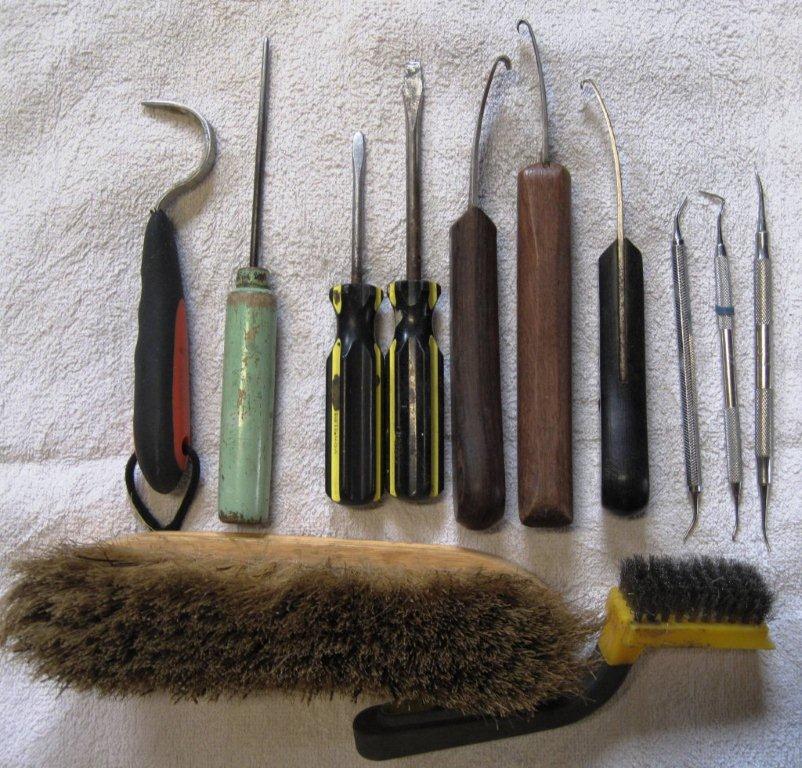

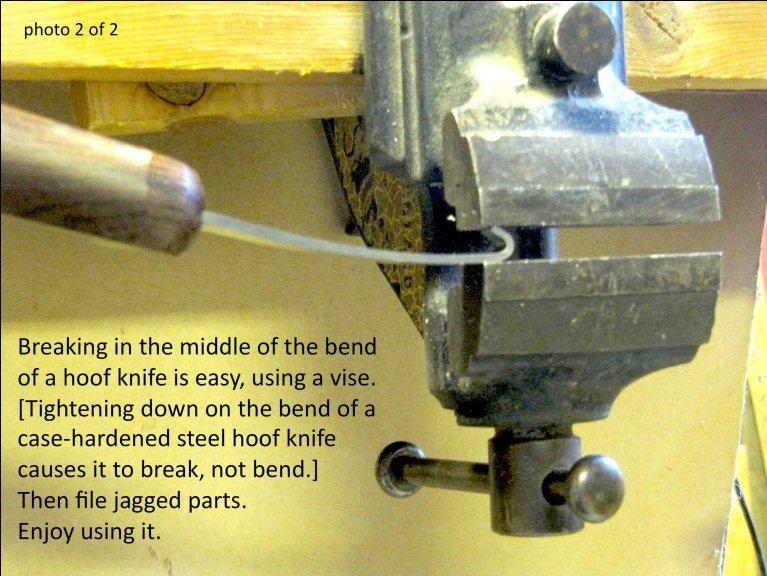
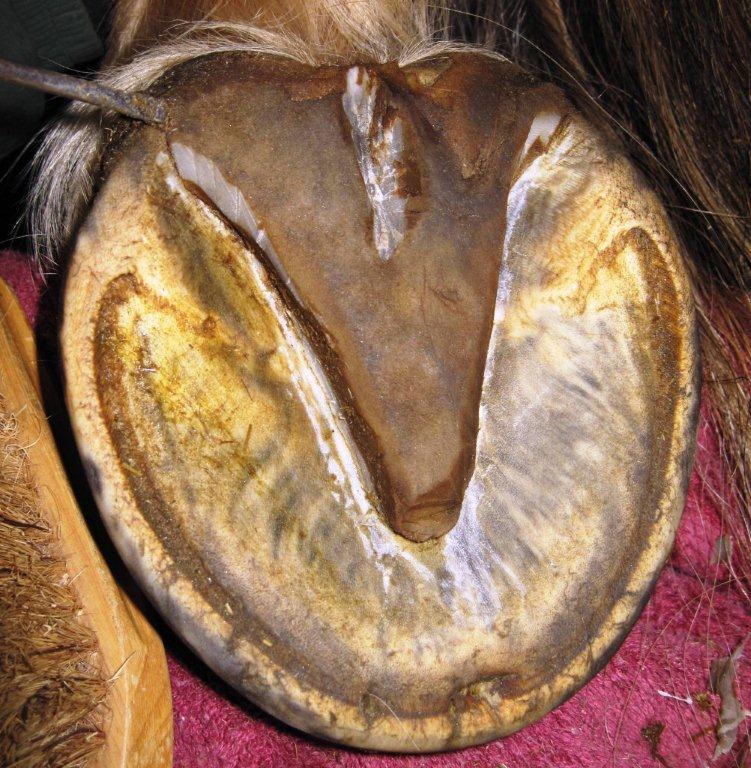
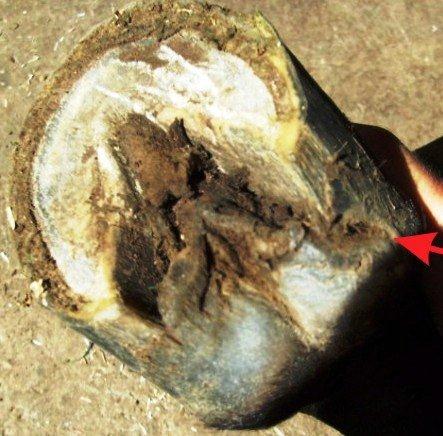
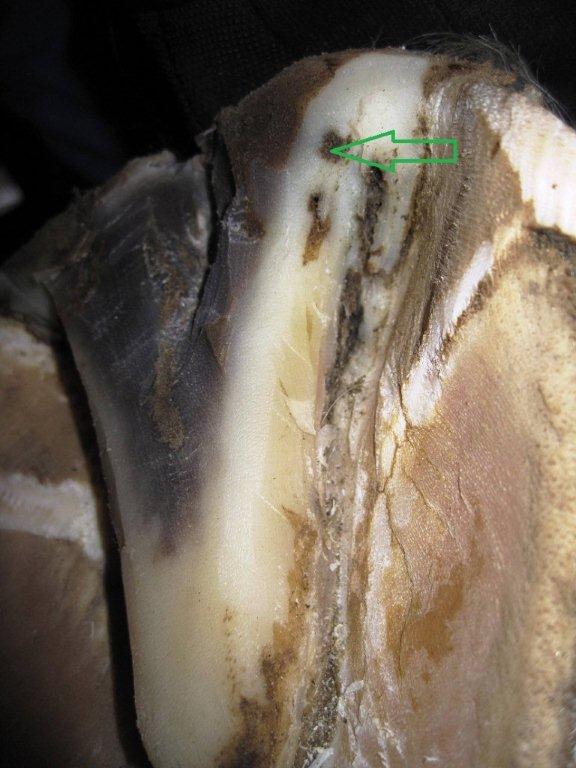
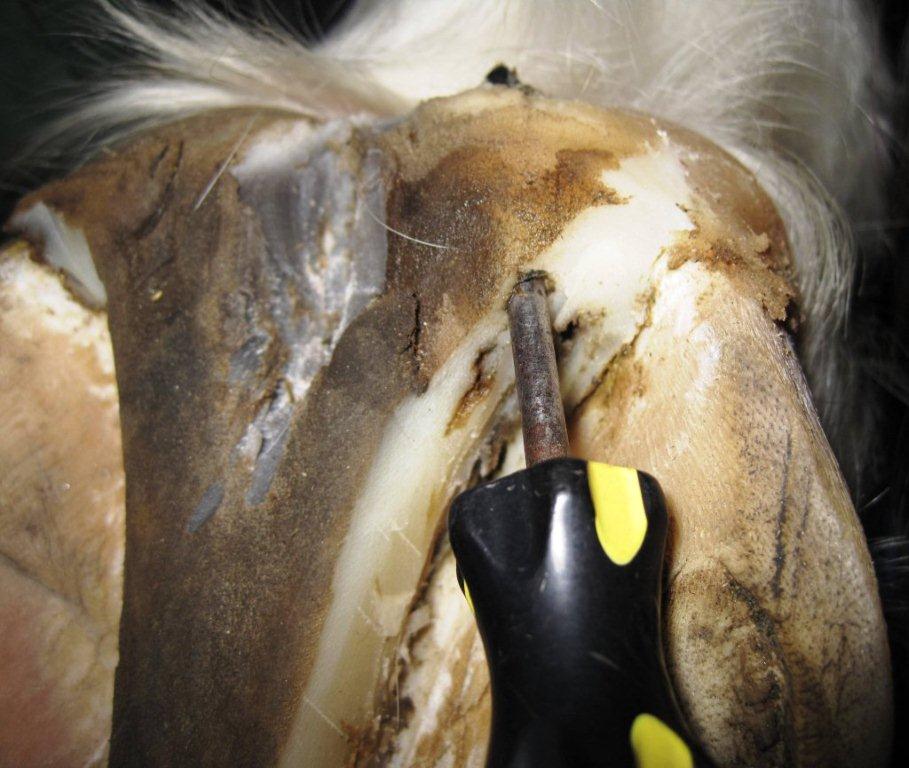


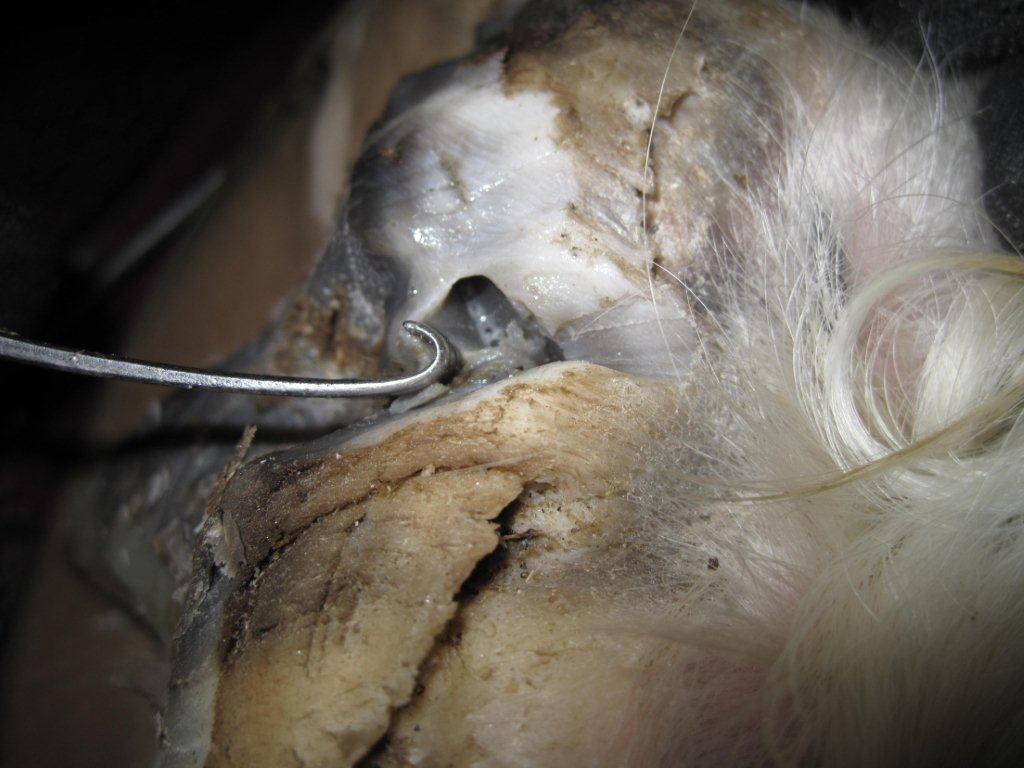
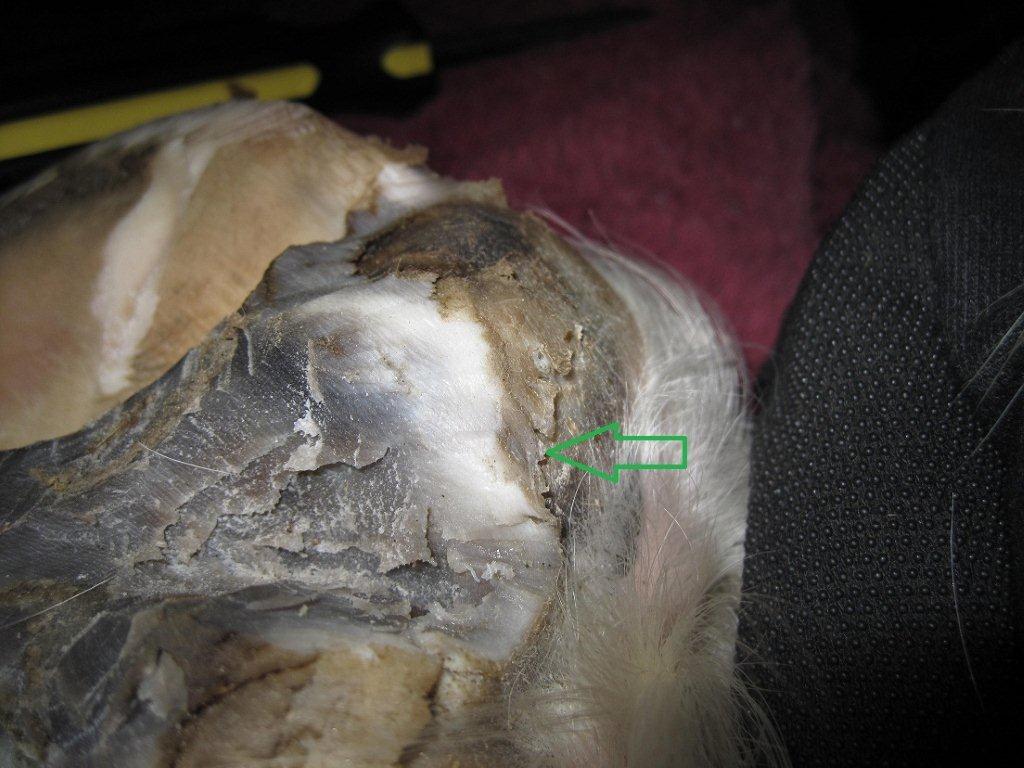

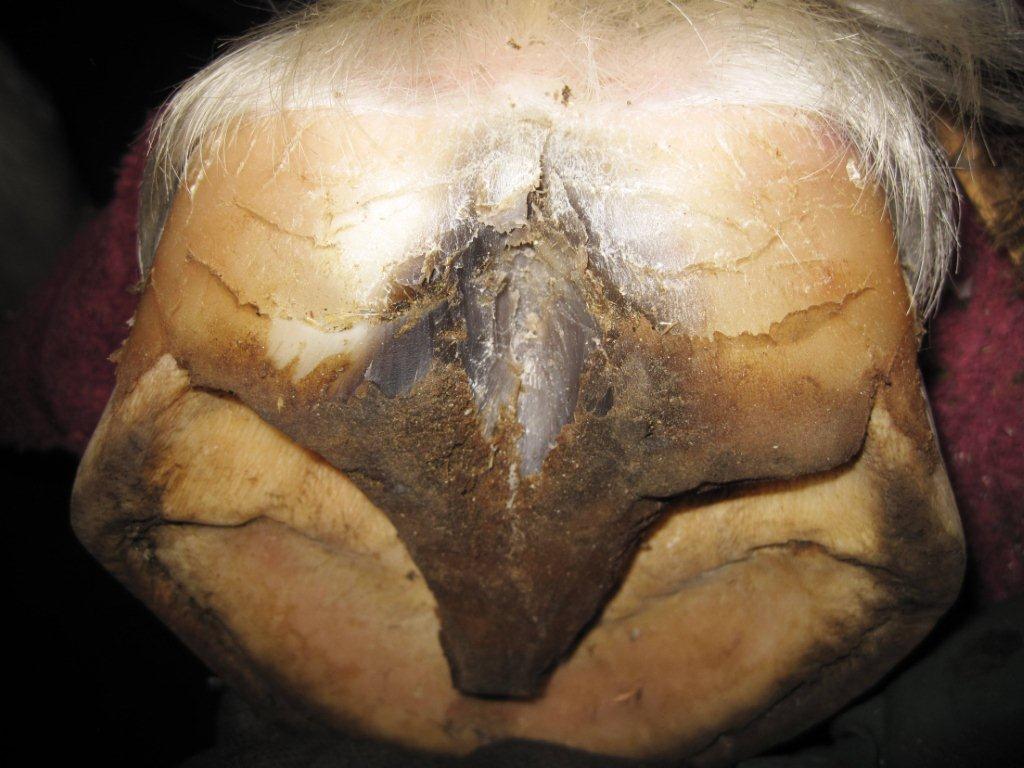
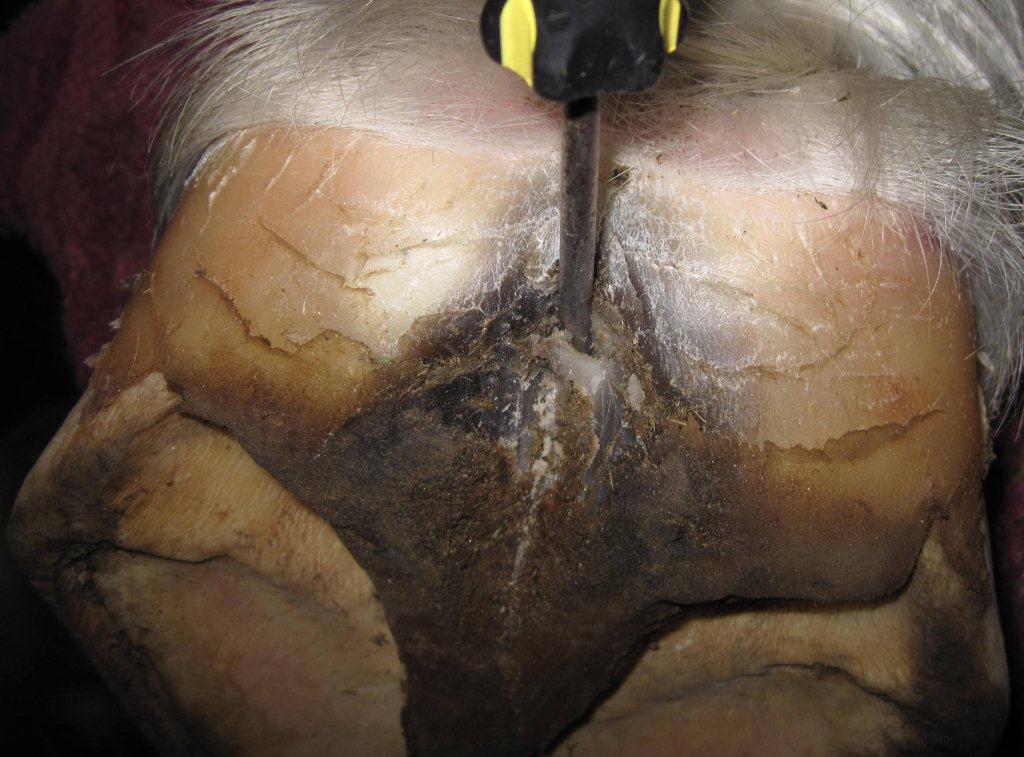


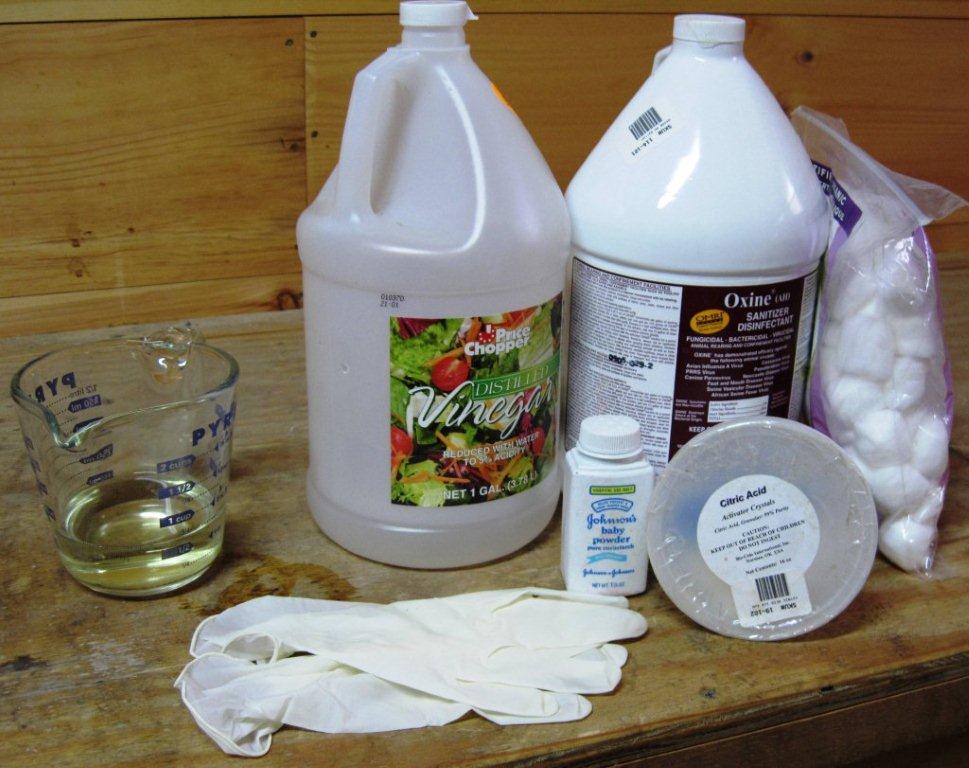
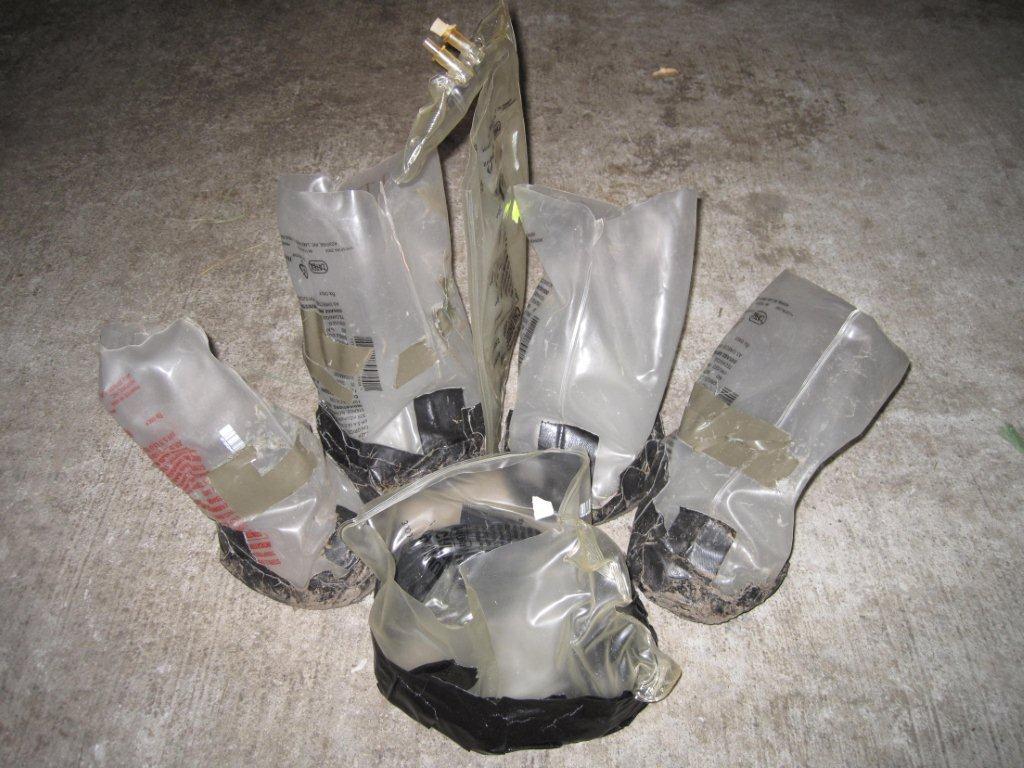
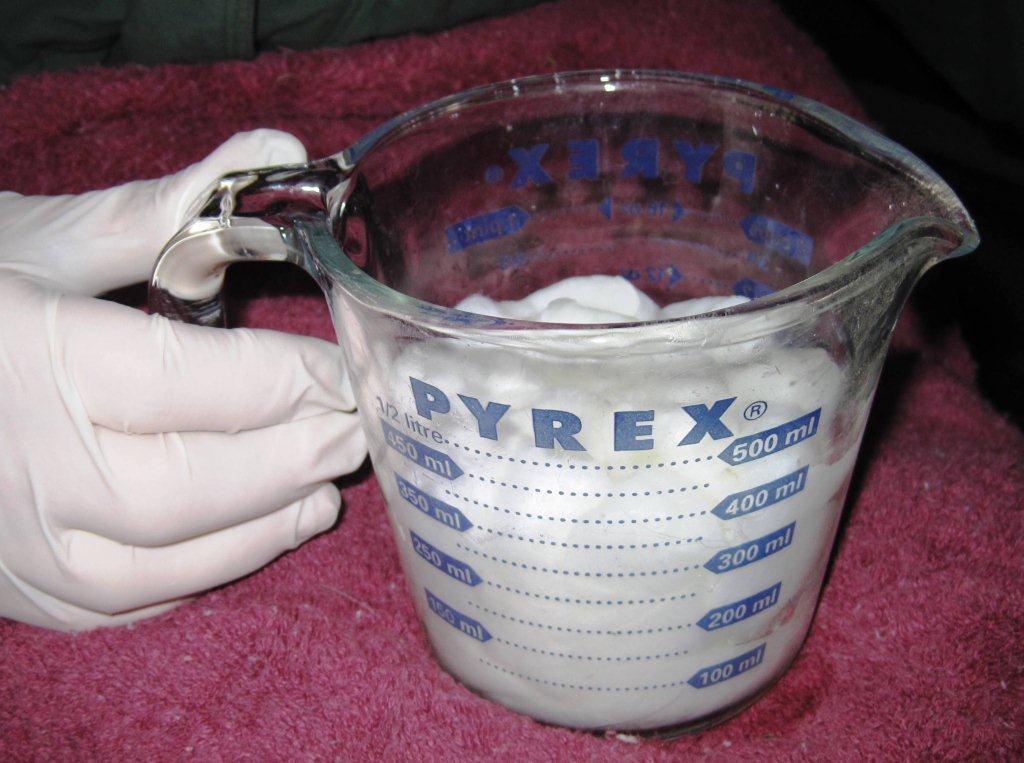
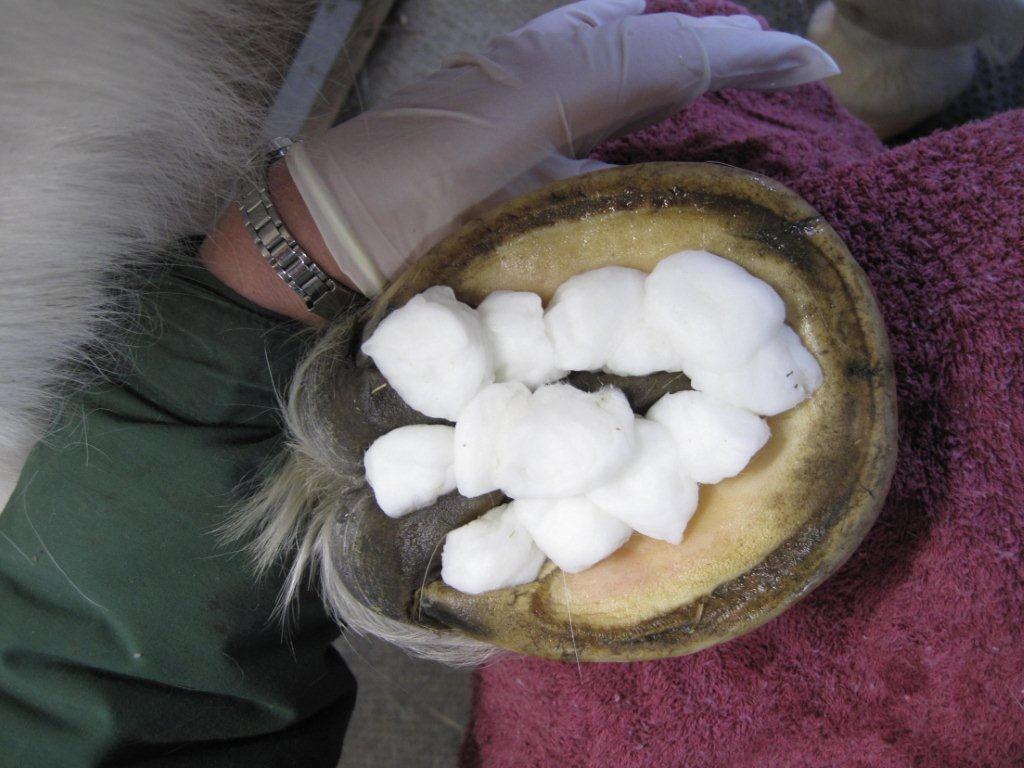

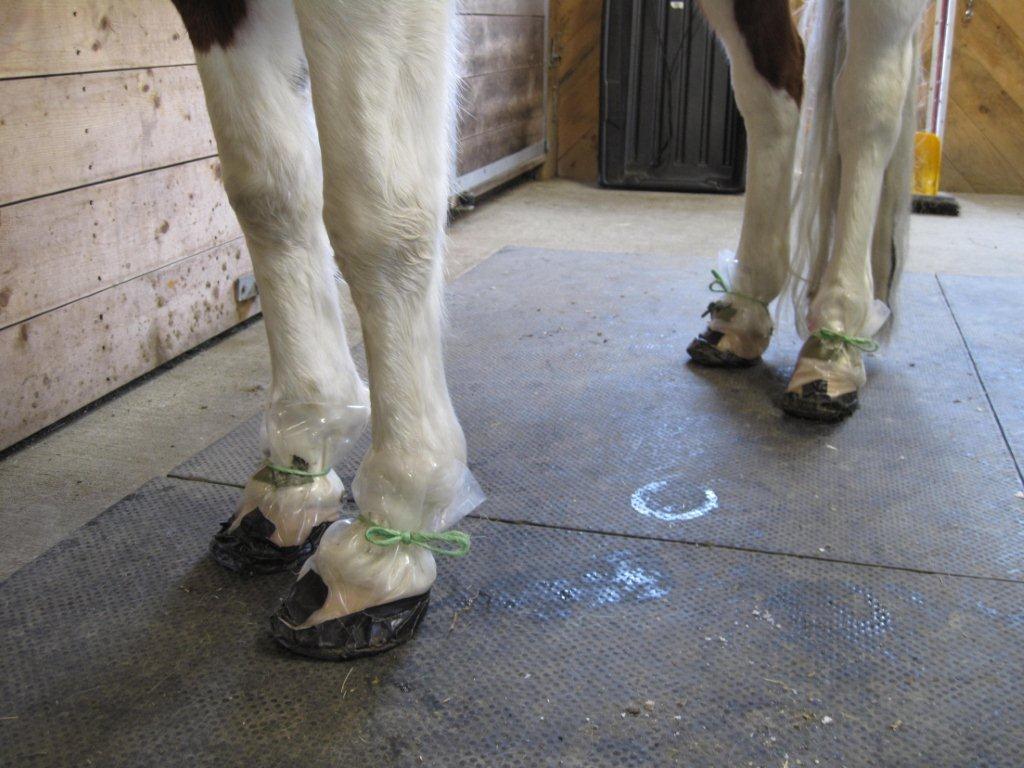

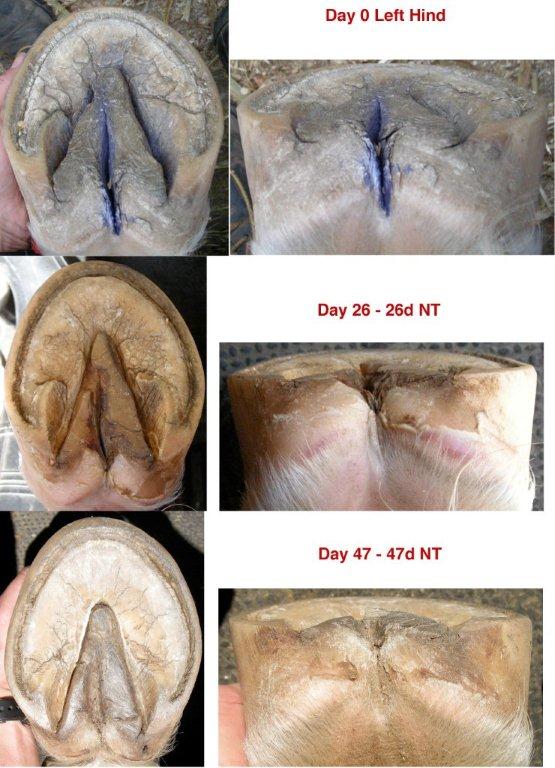 Preventative Maintenance
Preventative Maintenance
